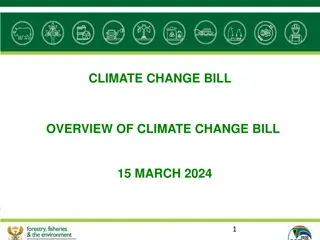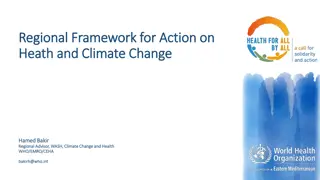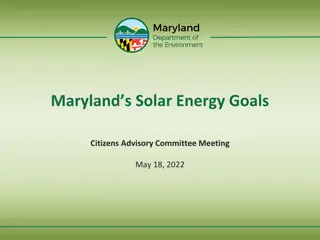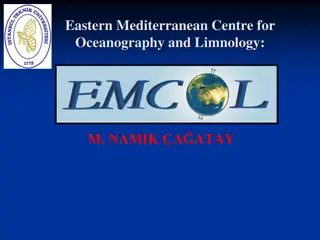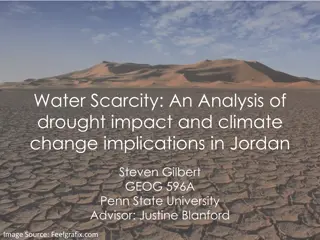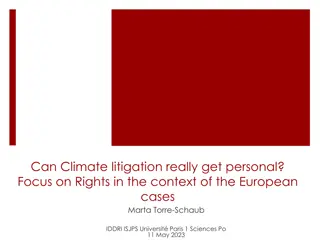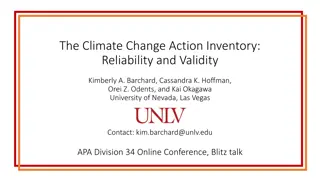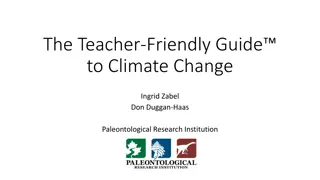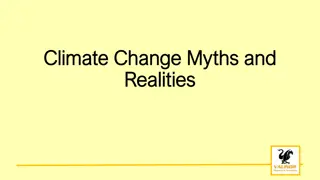Understanding Climate Change Through Paleoclimatology
This presentation delves into the study of past climates using proxy data such as corals and tree rings. By examining natural recorders like ice cores and fossilized pollen, scientists can reconstruct historical climate variations. The visuals showcase how data from sources like coral cores and tree rings provide insights into temperature trends over centuries, aiding in understanding present and future climate changes.
Download Presentation

Please find below an Image/Link to download the presentation.
The content on the website is provided AS IS for your information and personal use only. It may not be sold, licensed, or shared on other websites without obtaining consent from the author. Download presentation by click this link. If you encounter any issues during the download, it is possible that the publisher has removed the file from their server.
E N D
Presentation Transcript
Climate Change: Present, Past, and Future Based on an article and graphics by David S. Chapman and Michael G. Davis, Department of Geology and Geophysics, University of Utah, Salt Lake City, Utah featuring datasets considered by the Intergovernmental Panel on Climate Change and the National Research Council Slide set produced by LuAnn Dahlman NOAA climate office
Introduction This presentation shows scientific estimates of global average temperature from 1000 to 2100. Each dataset, calculated from instrumental records, proxy records, or projections, has been published in peer- reviewed literature. Additional information explaining how those temperatures were derived is on the slides that follow the graphs of the datasets. Full citations for each dataset are included on the explanation slides. Notes about each slide are available in the downloadable PowerPoint, in Normal view.
Paleoclimatology: The study of past climate, from times prior to instrumental weather measurements. Proxy Data Information from natural recorders of climate variability. Widely used proxy climate data include: Corals Tree Rings Ice Core records Fossilized Tree Pollen Boreholes Glacier Lengths
Paleoclimatology - The study of past climate, from times prior to instrumental weather measurements. Corals Corals build their hard skeletons from calcium carbonate, a mineral extracted from sea water. The carbonate contains isotopes of oxygen, as well as trace metals, that can be used to determine the temperature of the water in which the coral grew. These temperature recordings can then be used to reconstruct climate when the coral lived. Shown above are two sections of a coral core from the Galapagos. The cores are x-rayed so scientists can see the growth bands. Next, segments are marked for sampling: black lines represent annual bands, blue and red lines subdivide the year into quarters. The core is then cut along the lines and the individual segments analyzed in a laboratory .
Paleoclimatology - The study of past climate, from times prior to instrumental weather measurements. Tree Rings Since tree growth is influenced by climatic conditions, patterns in tree- ring widths, density, etc, reflect variations in climate. In temperate regions where there is a distinct growing season, trees generally produce one ring a year, and thus record the climatic conditions of each year. Trees can grow to be hundreds to thousands of years old and can contain annually-resolved records of climate for centuries to millennia. Shown at right is a cross section of a young conifer
Paleoclimatology - The study of past climate, from times prior to instrumental weather measurements. Ice Cores Located high in mountains and the polar ice caps, ice accumulates from snowfall compressed over many thousands of years. Scientists drill through the deep ice to collect ice cores that contain dust, air bubbles, or isotopes of oxygen, that can be used to interpret the past climate of that area. Shown above is a section of an ice core taken on the Clark Glacier in the McMurdo Dry Valleys. A 160-meter core was extracted to study the climate in the area over the past 2,000 years.
Paleoclimatology - The study of past climate, from times prior to instrumental weather measurements. Fossilized Pollen All flowering plants produce pollen grains. Their distinctive shapes can be used to identify the type of plant from which they came. Pollen grains are well preserved in the sediment layers of ponds, lakes or the ocean. An analysis pollen grains in each layer tell us what kinds of plants were growing at the time the sediment was deposited. Inferences can then be made about the climate based on the types of plants found in each layer. The image right, shows features of pollen spores from the Florida Everglades (USGS)
Paleoclimatology - The study of past climate, from times prior to instrumental weather measurements. Glacier Lengths A study of glacier length over time indicates the change in temperature. Scientists have recorded the activity of 169 glaciers from around the world. A glacier that is becoming longer is growing due to accumulation of snow. A glacier that is receding is loosing mass. Most glaciers world wide are showing similar loss of mass. The image, above, is an aerial view of glaciers.
Paleoclimatology - The study of past climate, from times prior to instrumental weather measurements. Borehole data Borehole data are direct measurements of temperature from boreholes drilled into the Earth crust. Departures from the expected increase in temperature with depth (the geothermal gradient) can be interpreted in terms of changes in temperature at the surface in the past. These changes in temperature have slowly diffused downward, warming or cooling layers meters below the surface. The image to the right is a borehole drill.
From 1850 through the present, systematic instrumental measurements of temperature can be compiled to estimate annual values for average global temperature. This record is shown in black, below.
All proxy records, shown by the green line, are smoothed to reflect variation on the scale of decades or longer. Note the similarities of the proxy and instrumental records from the year 1800 to present.
Additional sets of proxy records, drawn in the next few slides, show similar patterns.
Additional sets of proxy records, show a similar patterns.
This line represents the change in temperature of 1.1 C since the 1700s.
The next few slides show projections of future temperature based on the IPCC scenarios: C3, B1, A1B, A2. Each scenario is slightly different, and less optimistic. In the C3 storyline, CO2 concentrations are held at the same level as they were in 2000. The projection indicates that the world will continue to warm through 2100 due to the lengthy response time of the climate system. B1 population peaks at about 8.7 billion at mid-century, then declines to around 7 billion at the end of the century. In this scenario, countries come together to use both technology and general environmental controls to decrease emissions, leading to a temperature increase of less than 2 C above the year 2000 level. The A1B story line has population peak around 8.7 billion at midcentury, then decrease toward 7 billion at the end of the century. This scenario entertains efficient technologies with a balance between fossil fuel and non fossil fuel energy sources. Global temperature increase in scenario A1B is ~2.5 C. In scenario A2, population increases at current growth rates to 15 billion in 2100, accompanied by a heterogeneous economic theme of self- reliance and preservation of local identities. Global temperature increase with scenario A2 approaches 4 C by 2100.
Note: The next few slides provide more information and credits for the datasets presented in this PowerPoint. They are optional information.
Instrumental Record Surface temperatures for Earth are most reliably known for the period 1850 to present. This is the time for which there has been reasonable global coverage of stations measuring temperature in a systematic manner. The records show that since 1850, global average temperature increased by about 0.8 C, with much of the warming occurring since 1975. ---------------------------------------------------------------------------------------------------------------------- Philip Brohan and colleagues at universities in the United Kingdom published this record of global average temperatures (called HadCRUT3). The data set was based on a previous global temperature data set called HadCRUT which was derived from instrumental records. The old temperature record was modified to reflect improvements in estimating sea surface temperature and land data. The study also included a comprehensive set of uncertainty estimates for the data, including estimates of measurement and sampling error, temperature bias effects, and the effect of limited observational coverage on large-scale averages. Brohan, P., J. J. Kennedy, I. Harris, S. F. B. Tett, and P. D. Jones (2006), Uncertainty estimates in regional and global observed temperature changes: A new data set from 1850, J. Geophys. Res., 111, D12106, doi:10.1029/2005JD006548.
Proxy Records Temperatures can be deduced from natural records such as Tree rings Sediments in the ocean or lakes Corals Subsurface rock, soil, or ice temperatures Layers of ice In Slide Show mode, click any item above for further information ---------------------------------------------------------------------------------------------------------- The Esper et. al. record was extracted from tree-ring chronologies from 14 sites in the Northern Hemisphere. At the time of publication, Jan Esper and and Fritz Schweingruberwere affiliated with the Swiss Federal Research Institute in Switzerland. Edward Cook was affiliated with Lamont-Doherty Earth Observatory at Columbia University, New York, in the United States. Esper, J., E. R. Cook, and F. H. Schweingruber (2002), Low-Frequency Signals in Long Tree-Ring Chronologies for Reconstructing Past Temperature Variability Science 22 March 2002: Vol. 295 no. 5563 pp. 2250-2253 DOI: 10.1126/science.1066208
Proxy Records Temperatures can be deduced from natural records such as Tree rings Sediments in the ocean or lakes Corals Subsurface rock, soil, or ice temperatures Layers of ice In Slide Show mode, click any item above for further information ---------------------------------------------------------------------------------------------------------- The Mann and Jones record of past temperatures is based on ice boreholes, ice cores, sediment records, and tree-ring chronologies. At the time of publication, Michael E. Mann was affiliated with the Department of Environmental Sciences at the University of Virginia in Charlottesville, Virginia in the USA. Philip D. Jones is affiliated with the Climatic Research Unit at University of East Anglia in Norwich, in the United Kingdom. Mann, M. E., and P. D. Jones (2003), Global Surface Temperatures over the Past Two Millennia Geophysical Research Letters Vol. 30, No. 15, 1820, August 2003 doi: 10.1029/2003GL017814
Proxy Records Temperatures can be deduced from natural records such as Tree rings Sediments in the ocean or lakes Corals Subsurface rock, soil, or ice temperatures Layers of ice In Slide Show mode, click any item above for further information ---------------------------------------------------------------------------------------------------------- Anders Moberg and colleagues from Sweden and Russia published a temperature record deduced from tree rings and lake and ocean sediments. Moberg, A., D. M. Sonechkin, K. Holmgren, N. M. Datsenko, and W. Karl n (2005), Highly variable Northern Hemisphere temperatures reconstructed from low- and high-resolution proxy data Nature, Vol. 433, No. 7026, pp. 613 - 617, 10 February 2005.
Proxy Records Temperatures can be deduced from natural records such as Tree rings Sediments in the ocean or lakes Corals Subsurface rock, soil, or ice temperatures Layers of ice In Slide Show mode, click any item above for further information ---------------------------------------------------------------------------------------------------------- Gabriele Hegerl, along with two of her Duke University colleagues and a collaborator in the United Kingdom developed their temperature reconstruction as follows: We use large-ensemble energy balance modeling and simulate the temperature response to past solar, volcanic and greenhouse gas forcing to determine which climate sensitivities yield simulations that are in agreement with proxy reconstructions. After accounting for the uncertainty in reconstructions and estimates of past external forcing, we find an independent estimate of climate sensitivity that is very similar to those from instrumental data. Hegerl, G. C., T. J. Crowley, W. T. Hyde, and D. J. Frame (2006), Climate sensitivity constrained by temperature reconstructions over the past seven centuries. Nature 440, 1029-1032 (20 April 2006) | doi:10.1038/nature04679
Glacier Lengths Historical paintings, photographs, and other documents enable researchers to estimate the change in glacier mass balance over time and deduce corresponding temperatures. Additionally, dating of plant materials that were covered by glaciers and recently exposed provide information about the timing of changes in glacier lengths. ---------------------------------------------------------------------------------------------------------- J. Oerlemans of the Institute for Marine and Atmospheric Research at Utrecht University in the Netherlands constructed a temperature history for different parts of the world from 169 glacier length records. Using a first-order theory of glacier dynamics, he related changes in glacier length to changes in temperature. The derived temperature histories are fully independent of proxy and instrumental data used in earlier reconstructions. Oerlemans, J. (2005) Extracting a Climate Signal from 169 Glacier Records Science Vol. 308, No. 5722, pp. 675-677, 29 April 2005.
Borehole Temperatures Subsurface temperatures measured in boreholes register not only the steady state heat flowing out from Earth s interior, but also changes in past surface temperature. Heat of the Earth s atmosphere diffuses into the Earth s crust such that progressively deeper regions of the subsurface hold signatures for the temperatures of progressively older times. More information on boreholes > ---------------------------------------------------------------------------------------------------------- Shaopeng Huang and a colleague at the University of Michigan, working with a collaborator from Canada used present-day temperatures in 616 boreholes from all continents except Antarctica to reconstruct century-long trends in temperatures over the past 500 years at global, hemispheric and continental scales. Huang, S.. Pollack, H.N. & Shen, P.-Y. Temperature trends over the past five centuries reconstructed from borehole temperatures. Nature 403, 756-758 (17 February 2000) | doi:10.1038/35001556
Borehole + Surface Air Temperatures Subsurface temperatures measured in boreholes register not only the steady state heat flowing out from Earth s interior, but also changes in past surface temperature. Heat of the Earth s atmosphere diffuses into the Earth s crust such that progressively deeper regions of the subsurface hold signatures for the temperatures of progressively older times. ---------------------------------------------------------------------------------------------------------- Robert N. Harris and David S. Chapman, working at the University of Utah in the United States developed a temperature reconstruction using a hybrid approach that utilized both borehole and surface air temperature information. Their method yielded a baseline temperature prior to the instrumental record suggesting warming of about 1.1 C since ~1750. Harris, R. N., and D. S. Chapman (2001), Mid latitude (30 warming inferred by combining borehole temperatures with surface air temperatures, Geophys. Res. Lett., 28(5), 747 750, doi:10.1029/2000GL012348. 60 N) climatic
Future Climate Projections: Intergovernmental Panel on Climate Change (IPCC) For its Fourth Assessment Report released in 2007, the IPCC considered several possible futures based on factors including population growth, economic development, and technological change. Each scenario was linked to estimates of how the concentration of greenhouse gases in the atmosphere would change over time. Twenty-three different climate models used the scenarios as input to make projections of global average temperature through the year 2100. Solid lines represent the average projection; shaded areas show the range of results. ---------------------------------------------------------------------------------------------------------- In the C3 storyline, CO2 concentrations are held at the same level as they were in 2000. The projection indicates that the world will continue to warm through 2100 due to the lengthy response time of the climate system. Intergovernmental Panel on Climate Change (IPCC) (2007), Climate Change 2007: The Physical Science Basis Contribution of Working Group I to the Fourth Assessment Report of the Intergovernmental Panel on Climate Change, edited by S. Solomon et al., 996 pp., Cambridge Univ. Press, New York.
Future Climate Projections: Intergovernmental Panel on Climate Change (IPCC) For its Fourth Assessment Report released in 2007, the IPCC considered several possible futures based on factors including population growth, economic development, and technological change. Each scenario was linked to estimates of how the concentration of greenhouse gases in the atmosphere would change over time. Twenty-three different climate models used the scenarios as input to make projections of global average temperature through the year 2100. Solid lines represent the average projection; shaded areas show the range of results. ---------------------------------------------------------------------------------------------------------- B1 population peaks at about 8.7 billion at mid-century, then declines to around 7 billion at the end of the century. In this scenario, countries come together to use both technology and general environmental controls to decrease emissions, leading to a temperature increase of less than 2 C above the year 2000 level. Intergovernmental Panel on Climate Change (IPCC) (2007), Climate Change 2007: The Physical Science Basis Contribution of Working Group I to the Fourth Assessment Report of the Intergovernmental Panel on Climate Change, edited by S. Solomon et al., 996 pp., Cambridge Univ. Press, New York.
Future Climate Projections: Intergovernmental Panel on Climate Change (IPCC) For its Fourth Assessment Report released in 2007, the IPCC considered several possible futures based on factors including population growth, economic development, and technological change. Each scenario was linked to estimates of how the concentration of greenhouse gases in the atmosphere would change over time. Twenty-three different climate models used the scenarios as input to make projections of global average temperature through the year 2100. Solid lines represent the average projection; shaded areas show the range of results. ---------------------------------------------------------------------------------------------------------- The A1B story line has population peak around 8.7 billion at midcentury, then decrease toward 7 billion at the end of the century. This scenario entertains efficient technologies with a balance between fossil fuel and non fossil fuel energy sources. Global temperature increase in scenario A1B is ~2.5 C. Intergovernmental Panel on Climate Change (IPCC) (2007), Climate Change 2007: The Physical Science Basis Contribution of Working Group I to the Fourth Assessment Report of the Intergovernmental Panel on Climate Change, edited by S. Solomon et al., 996 pp., Cambridge Univ. Press, New York.
Future Climate Projections: Intergovernmental Panel on Climate Change (IPCC) For its Fourth Assessment Report released in 2007, the IPCC considered several possible futures based on factors including population growth, economic development, and technological change. Each scenario was linked to estimates of how the concentration of greenhouse gases in the atmosphere would change over time. Twenty-three different climate models used the scenarios as input to make projections of global average temperature through the year 2100. Solid lines represent the average projection; shaded areas show the range of results. ---------------------------------------------------------------------------------------------------------- In scenario A2, population increases at current growth rates to 15 billion in 2100, accompanied by a heterogeneous economic theme of self- reliance and preservation of local identities. Global temperature increase with scenario A2 approaches 4 C by 2100. Intergovernmental Panel on Climate Change (IPCC) (2007), Climate Change 2007: The Physical Science Basis Contribution of Working Group I to the Fourth Assessment Report of the Intergovernmental Panel on Climate Change, edited by S. Solomon et al., 996 pp., Cambridge Univ. Press, New York.
Tree Rings (Text from http://www.nap.edu/catalog/11676.html) Tree ring formation is influenced by climatic conditions, especially in areas near the edge of the geographic distribution of tree species. At high latitudes and/or at high elevations, tree ring growth is related to temperature, and thus trees from these sites are commonly used as a basis for surface temperature reconstructions. Cores extracted from the trees provide annually resolved time series of tree ring width and of wood properties, such as density and chemical composition, within each ring. In some cases, records from living trees can be matched with records from dead wood to create a single, continuous chronology extending back several thousand years. Tree ring records offer a number of advantages for climate reconstruction, including wide geographic availability, annual to seasonal resolution, ease of replication, and internally consistent dating. Like other proxies, tree rings are influenced by biological and environmental factors other than climate. Site selection and quality control procedures have been developed to account for these confounding factors. In the application of these procedures, emphasis is placed on replication of records both within a site and among sites and on numerical calibration against instrumental data. ---------------------------------------------------------------------------------------------------------- Surface Temperature Reconstructions for the Last 2,000 Years (2006) Committee on Surface Temperature Reconstructions for the Last 2,000 Years, National Research Council. ISBN: 0-309-66144-7, 160 pages http://www.nap.edu/catalog/11676.html
Corals (Text from http://www.nap.edu/catalog/11676.html) The annual bands in coral skeletons provide information about environmental conditions at the time that each band was formed. This information is mostly derived from changes in the chemical and isotopic composition of the coral, which reflects the temperature and isotopic composition of the water in which it formed. Since corals live mostly in tropical and subtropical waters, they provide a useful complement to records derived from tree rings. Coral skeleton chemistry is influenced by several variables, and thus care must be taken when selecting coral samples and when deriving climate records from them. Thus far, most of the climate reconstructions based on corals have been regional in scale and limited to the last few hundred years, but there is now work toward establishing longer records by sampling fossil corals. ---------------------------------------------------------------------------------------------------------- Surface Temperature Reconstructions for the Last 2,000 Years (2006) Committee on Surface Temperature Reconstructions for the Last 2,000 Years, National Research Council. ISBN: 0-309-66144-7, 160 pages http://www.nap.edu/catalog/11676.html
Ice Cores (Text from http://www.nap.edu/catalog/11676.html) Oxygen isotopes measured in ice cores extracted from glaciers and ice caps can be used to infer the temperature at the time when the snow was originally deposited. For the most recent 2,000 years, the age of the ice can in most places be determined by counting annual layers. The isotopic composition of the ice in each layer reflects both the temperature in the region where the water molecules originally evaporated far upwind of the glacier and the temperature of the clouds in which the water vapor molecules condensed to form snowflakes. The long-term fluctuations in temperature reconstructions derived from ice cores can be cross-checked against the vertical temperature profiles in the holes out of which they were drilled (see below). Ice-isotope- based reconstructions are available only in areas that are covered with ice that persists on the landscape (e.g., Greenland, Antarctica, and some ice fields atop mountains in Africa, the Andes, and the Himalayas). The interpretation of oxygen isotope measurements in tropical ice cores is more complicated than for polar regions because it depends not only on temperature but also on precipitation in the adjacent lowlands. ---------------------------------------------------------------------------------------------------------- Surface Temperature Reconstructions for the Last 2,000 Years (2006) Committee on Surface Temperature Reconstructions for the Last 2,000 Years, National Research Council. ISBN: 0-309-66144-7, 160 pages http://www.nap.edu/catalog/11676.html
Marine and Lake Sediments (Text from http://www.nap.edu/catalog/11676.html) Cores taken from the sediments at the bottoms of lakes and ocean regions can be analyzed to provide evidence of past climatic change. Sediment cores can be analyzed to determine the temperature of the water from which the various constituents of the sediment were deposited. This information, in turn, can be related to the local surface temperature. Records relevant to temperature include oxygen isotopes, the ratio of magnesium to calcium, and the relative abundance of different microfossil types with known temperature preferences (such as insects) or with a strong temperature correlation (e.g., diatoms and some other algae). Changes in the properties of sediments are also of interest. For example, during cold epochs icebergs streaming southward over the North Atlantic carried sand and gravel and deposited it in sediments at the latitudes where they melted; the properties of this material are indicative of the generally colder conditions in the region where the icebergs originated. Ocean and lake sediments typically accumulate slowly, and the layering within them tends to be smoothed out by bottom-dwelling organisms. Hence it is only in regions where sedimentation rates are extraordinarily high (e.g., the Bermuda Rise, the northwest coast of Africa) or in a few oxygen-deprived areas (e.g., the Santa Barbara Basin, the Cariaco Basin off Venezuela, or in deep crater lakes) that sediments can be dated accurately enough to provide information on climate changes during the last 2,000 years. More slowly accumulating sediments from ocean basins throughout the world are one of our main sources of information on climate variations on timescales of millennia and longer. ---------------------------------------------------------------------------------------------------------- Surface Temperature Reconstructions for the Last 2,000 Years (2006) Committee on Surface Temperature Reconstructions for the Last 2,000 Years, National Research Council. ISBN: 0-309- 66144-7, 160 pages http://www.nap.edu/catalog/11676.html
Boreholes (Text from http://www.nap.edu/catalog/11676.html) Past surface temperatures can be estimated by measuring the vertical temperature profile down boreholes drilled into rock, frozen soils, and ice. Temperature variations at the Earth s surface diffuse downward with time by the same process that causes the handle of a metal spoon to warm up when it is immersed in a cup of hot tea. The governing equation for this process can be used to convert the vertical profile of temperature in a borehole into a record of surface temperature versus time. Features in the vertical temperature profile are smoothed out as they propagate downward, resulting in a loss of information. Hence, large-scale surface temperature reconstructions based on borehole measurements typically extend back only over a few centuries, with coarse time resolution. Hundreds of holes have been drilled to depths of several hundred meters below the surface at sites throughout the Northern Hemisphere and at a smaller number of sites in the Southern Hemisphere. Many of these boreholes of opportunity were drilled for other reasons such as mineral exploration. Specialists acknowledge several different types of errors in borehole- based temperature reconstructions, such as an imperfect match between ground temperature and near-surface air temperature, but available evidence indicates that these errors do not significantly influence reconstructions for large regions using many boreholes. Boreholes drilled through glacial ice to extract ice cores are free from many of these problems and can be analyzed jointly with the oxygen isotope record from the corresponding core, yielding a much longer and more accurate temperature reconstruction than is possible with boreholes drilled through rock or permafrost. However, ice-based boreholes are available only in areas with a thick cover of ice. ------------------------------------------------------------------------------------------------------------------------------------ Surface Temperature Reconstructions for the Last 2,000 Years (2006) Committee on Surface Temperature Reconstructions for the Last 2,000 Years, National Research Council. ISBN: 0-309- 66144-7, 160 pages http://www.nap.edu/catalog/11676.html








